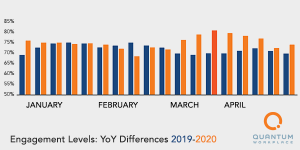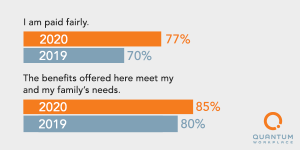Not long ago, the National Bureau of Economic Research officially declared that the United States entered into a recession in February 2020, ending one of the longest periods of economic uptick and expansion in our history. Yet despite the challenges and grim economic outlook, a study conducted by Quantum Workplace using data from its 2019 and 2020 Best Places to Work surveys, revealed employee engagement grew meaningfully during the COVID-19 crisis at 73% of organizations.
Specifically, the peak in employee engagement in early 2020 represented an 11% increase when compared with engagement levels during the same period in 2019. Prior to COVID-19, survey data revealed employee engagement had changed just 1 to 2 percentage points year-over-year for more than a decade.

Furthermore, employees’ desire to stay in their current jobs is at an all-time high. This may seem predictable as an economic crisis isn’t an ideal time to explore new job opportunities. However, other specific employee perceptions indicate that economic indicators do not explain the full story, with favorability in survey items related to leadership, communication, and wellbeing.
Rather than view this spike in employee engagement during the pandemic as a surprising or strange occurrence or write it off as a coincidence, perhaps it’s better to focus on why engagement rose during a time when many would expect the reverse.
Communication & Leadership
Throughout this disruption and forced change, there is evidence that organizations were responding positively. Eighty-eight percent of employees agreed that the frequency of communication from leaders was effective. And nearly 9 in 10 employees said they felt well-supported by their immediate manager during this time.
What’s more, the two surveys items with the largest increases in year-over-year favorability were around change management and leadership:

An explanation for this is the pandemic forced leaders to communicate more frequently, authentically, and transparently to inform, support, and inspire their people during a period of evolving uncertainty. Indeed, as leaders had less opportunity to physically see their employees during COVID-19, the need to listen to them became increasingly important.
This explains why the number of pulse surveys that our customers launched nearly doubled from Q1 to Q2 of this year. These surveys aimed to help organizations better understand:
- If employees have what they need to be productive
- Whether people feel connected to their manager and team
- If they feel informed about the company’s priorities
- Personal factors to consider to support employees’ work and personal lives
- Ideas employees have to improve current processes or procedures
Health, Wellbeing, & Balance
While COVID-19 has created numerous challenges, its disruption also provides opportunities to address wellbeing. For example, companies like Twitter and Facebook announced they will allow permanent work-from-home programs indefinitely. These and other actions afford workers better flexibility and help improve health, wellbeing, and balance — all of which are key to successful engagement.
And sure enough, findings show that employees felt their companies supported their wellbeing more this year than last:

Such changes in employee perceptions might stem from organizational leaders acting responsively to set guidelines and change policies, especially around remote work, to improve the health and wellbeing of their people during these challenging times.
Compensation & Benefits
Lastly, employee perceptions of fair compensation and good benefits also grew during this time period.

It’s worth noting, however, that these findings around pay and benefits do not indicate that employees suddenly received more pay or better benefits. Rather, they show that workers have different perceptions today about what a fair wage and good benefits look like during a global pandemic and economic recession. It’s therefore critical for companies to continually communicate their total rewards and be transparent about how they compensate their people
When the light at the end of the tunnel eventually surfaces on the heels of this pandemic, organizations should carry forward all these habits around communication, wellbeing, and leadership to continue to elevate engagement, improve productivity, and enhance performance.
